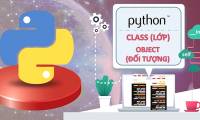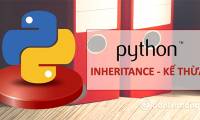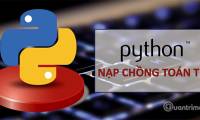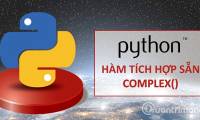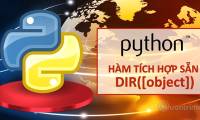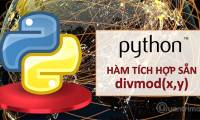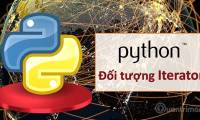
In order to learn well Python, it is essential that you find yourself an appropriate IDE to develop. Quantrimang would like to introduce some of the best environments to help
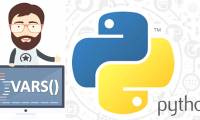
The vars () function in Python returns the __dict__ attribute of the passed object if the object has the __dict__ attribute.

The built-in function tuple () in Python is used to create a tuple.
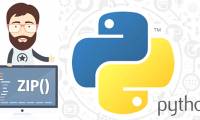
The zip () function in Python returns a zip object, a list iterator of tuples that combines elements from other iterators (made of iterable words).

If you take the time to learn programming trends on the Internet, you've probably heard of functional programming. Here are 5 functional programming languages you should know.

Python is an object-oriented programming language. Unlike procedural programming, which emphasizes functions, object-oriented programming focuses on objects. This article

Inheriting in object-oriented programming allows us to declare new classes to re-use the parent class's functions and attributes and extra functions. In this article, we will

Inheritance allows us to declare the new class to re-use the parent class's functions and attributes and extra functions. In this article, Quantrimang will continue the lesson

Guido van Rossum, a Dutch programmer, created Python in 1991. Python is based on a simple philosophy: Minimalist. One of the interesting things about Python is that it combines

You can change the meaning of the operator in Python depending on the operand used and we call that operator overloading. Quantrimang will learn more about this content through

In Python, the complex () function returns a complex number when the user provides a virtual and real part, or turns a string into a complex number. How does the complex ()

The compile () function returns a code object in Python from the specified source. So how to use compile () function? Please find out in this article.

The delattr () function in Python is used to delete an attribute from the specified object. How does the delattr () function have a syntax, what parameters do you have, please

In Python, the dict () function creates a dictionary type value. Quantrimang will learn more about the syntax, parameters and usage of the dict () function through this article.

The dir () function in Python returns a list of valid properties of the object. Quantrimang will learn more about this function content through the article. Invites you to read

Learn more about the syntax, parameters and usage of the built-in divmod () function in Python with Quantrimang.

Iterators are objects that allow us to take each of its elements, this action can be repeated. In this article, Quantrimang will discuss with you how the iterator works in Python

In Python, the enumerate () function adds a counter before each iterable and returns the result as an enumerate object. The article will elaborate on the syntax, parameters and

The float () function in Python converts the value specified to a floating-point number. How does the float () function have a syntax, what parameters do you have, how can you

In this article, Quantrimang will continue to introduce you to a built-in function in Python, eval (). Eval () is an interesting utility that allows you to run Python code (this
 In order to learn well Python, it is essential that you find yourself an appropriate IDE to develop. Quantrimang would like to introduce some of the best environments to help
In order to learn well Python, it is essential that you find yourself an appropriate IDE to develop. Quantrimang would like to introduce some of the best environments to help The vars () function in Python returns the __dict__ attribute of the passed object if the object has the __dict__ attribute.
The vars () function in Python returns the __dict__ attribute of the passed object if the object has the __dict__ attribute. The built-in function tuple () in Python is used to create a tuple.
The built-in function tuple () in Python is used to create a tuple. The zip () function in Python returns a zip object, a list iterator of tuples that combines elements from other iterators (made of iterable words).
The zip () function in Python returns a zip object, a list iterator of tuples that combines elements from other iterators (made of iterable words). If you take the time to learn programming trends on the Internet, you've probably heard of functional programming. Here are 5 functional programming languages you should know.
If you take the time to learn programming trends on the Internet, you've probably heard of functional programming. Here are 5 functional programming languages you should know. Python is an object-oriented programming language. Unlike procedural programming, which emphasizes functions, object-oriented programming focuses on objects. This article
Python is an object-oriented programming language. Unlike procedural programming, which emphasizes functions, object-oriented programming focuses on objects. This article Inheriting in object-oriented programming allows us to declare new classes to re-use the parent class's functions and attributes and extra functions. In this article, we will
Inheriting in object-oriented programming allows us to declare new classes to re-use the parent class's functions and attributes and extra functions. In this article, we will Inheritance allows us to declare the new class to re-use the parent class's functions and attributes and extra functions. In this article, Quantrimang will continue the lesson
Inheritance allows us to declare the new class to re-use the parent class's functions and attributes and extra functions. In this article, Quantrimang will continue the lesson Guido van Rossum, a Dutch programmer, created Python in 1991. Python is based on a simple philosophy: Minimalist. One of the interesting things about Python is that it combines
Guido van Rossum, a Dutch programmer, created Python in 1991. Python is based on a simple philosophy: Minimalist. One of the interesting things about Python is that it combines You can change the meaning of the operator in Python depending on the operand used and we call that operator overloading. Quantrimang will learn more about this content through
You can change the meaning of the operator in Python depending on the operand used and we call that operator overloading. Quantrimang will learn more about this content through In Python, the complex () function returns a complex number when the user provides a virtual and real part, or turns a string into a complex number. How does the complex ()
In Python, the complex () function returns a complex number when the user provides a virtual and real part, or turns a string into a complex number. How does the complex () The compile () function returns a code object in Python from the specified source. So how to use compile () function? Please find out in this article.
The compile () function returns a code object in Python from the specified source. So how to use compile () function? Please find out in this article. The delattr () function in Python is used to delete an attribute from the specified object. How does the delattr () function have a syntax, what parameters do you have, please
The delattr () function in Python is used to delete an attribute from the specified object. How does the delattr () function have a syntax, what parameters do you have, please In Python, the dict () function creates a dictionary type value. Quantrimang will learn more about the syntax, parameters and usage of the dict () function through this article.
In Python, the dict () function creates a dictionary type value. Quantrimang will learn more about the syntax, parameters and usage of the dict () function through this article. The dir () function in Python returns a list of valid properties of the object. Quantrimang will learn more about this function content through the article. Invites you to read
The dir () function in Python returns a list of valid properties of the object. Quantrimang will learn more about this function content through the article. Invites you to read Learn more about the syntax, parameters and usage of the built-in divmod () function in Python with Quantrimang.
Learn more about the syntax, parameters and usage of the built-in divmod () function in Python with Quantrimang. Iterators are objects that allow us to take each of its elements, this action can be repeated. In this article, Quantrimang will discuss with you how the iterator works in Python
Iterators are objects that allow us to take each of its elements, this action can be repeated. In this article, Quantrimang will discuss with you how the iterator works in Python In Python, the enumerate () function adds a counter before each iterable and returns the result as an enumerate object. The article will elaborate on the syntax, parameters and
In Python, the enumerate () function adds a counter before each iterable and returns the result as an enumerate object. The article will elaborate on the syntax, parameters and The float () function in Python converts the value specified to a floating-point number. How does the float () function have a syntax, what parameters do you have, how can you
The float () function in Python converts the value specified to a floating-point number. How does the float () function have a syntax, what parameters do you have, how can you In this article, Quantrimang will continue to introduce you to a built-in function in Python, eval (). Eval () is an interesting utility that allows you to run Python code (this
In this article, Quantrimang will continue to introduce you to a built-in function in Python, eval (). Eval () is an interesting utility that allows you to run Python code (this